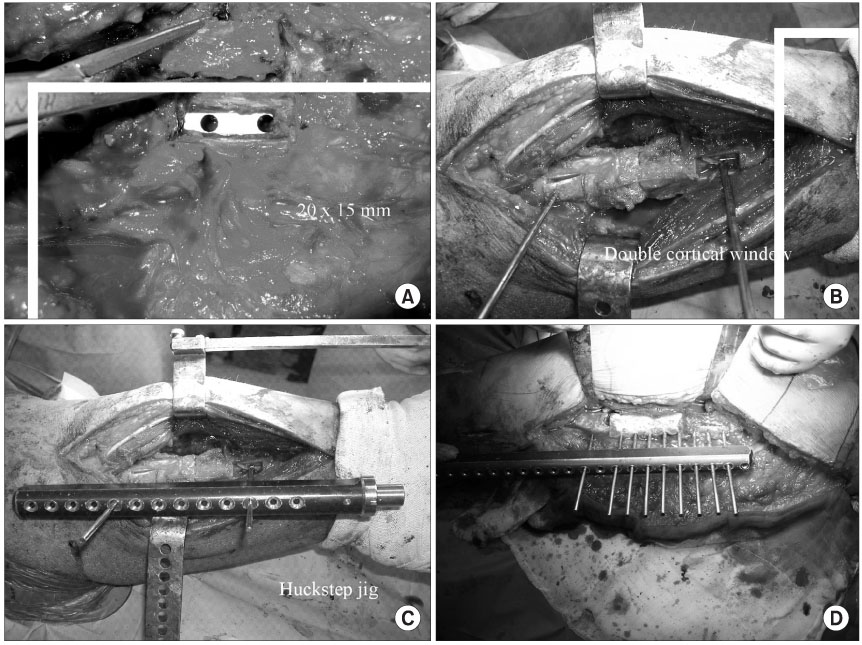J Korean Orthop Assoc.
2007 Feb;42(1):38-44. 10.4055/jkoa.2007.42.1.38.
Huckstep Nail in theTreatment of a Femur Fracture
- Affiliations
-
- 1Department of Orthopedic Surgery, Gyeong-Sang National University Hospital, Jinju, Korea. hscspine@nongae.gsnu.ac.kr
- KMID: 2106373
- DOI: http://doi.org/10.4055/jkoa.2007.42.1.38
Abstract
-
Purpose: To analyze the clinical and radiological results of Huckstep nailing in the treatment of acute femoral fractures and femoral nonunion, and to report the easy and non-fluoroscopic technique of targeting the locking screw holes by making double cortical windows.
Materials and Methods
This study examined a total of fifteen femoral fractures treated with Huckstep nailing between January 1999 and January 2004. The fractures included six acute fractures (five closed and one open) and nine nonunions (four infective and five aseptic). The reoperative status, number of interventions, time to union and complications were analyzed. Ten male and 5 female patients with an average age of 42 years (range, 18-70) were followed up for a mean of 26 months (range, 16 months to 6.4 years). A new method of double cortical windows for targeting the screw holes were performed in seven cases without fluoroscopic aid.
Results
Radiographic union was achieved after a mean of 15.3 weeks in those with an acute fracture and after a mean of 24.6 weeks in those with nonunion. One open fracture was fixed initially using a monofixator followed by Huckstep nail 4 weeks later when the open wound had healed. A bone graft was performed in two cases of nonunion, and Hydroxyapatite/Tricalcium phosphate granules were grafted in three cases of nonunion. Partial knee ankylosis resulted in 6 cases of nonunion at the final follow-up because the nonunion cases had undergone an average of 4.3 surgical procedures at other hospitals over an average of 11.8 months before performing Huckstep nailing. One acute case without proximal screw fixation resulted in dynamization and femoral shortening of 2 cm.
Conclusion
Huckstep nailing provides stable fixation sufficient to enable early knee motion and weight bearing until the fracture heals in both acute fracture and nonunion. The new method of double cortical windows allows the easy targeting of screw holes without fluoroscopic aid.
Keyword
MeSH Terms
Figure
Reference
-
1. Graham GP, Mackie IG. Experience with the A.O. locking femoral nail. Injury. 1988. 19:249–253.
Article2. Huckstep RL. The Huckstep intramedullary compression nail. Indication, technique, and results. Clin Orthop Relat Res. 1986. 212:48–61.3. Huckstep RL. Stabilization and prosthetic replacement in difficult fractures and bone tumors. Clin Orthop Relat Res. 1987. 224:12–25.
Article4. Kempf I, Grosse A, Beck G. Closed locked intramedullary nailing. It application to comminuted fracture of the femur. J Bone Joint Surg Am. 1985. 67:709–720.5. Kempf I, Grosse A, Rigaut P. The treatment of noninfected pseudarthrosis of the femur and tibia with locked intramedullary nailing. Clin Orthop Relat Res. 1986. 212:142–154.
Article6. Kim SK, Oh JY, Lee KB. The Huckstep intramedullary nailing for femoral shaft fractures. J Korean Orthop Assoc. 1985. 20:659–665.
Article7. Kim SK, Lee KB, Oh SJ, Ko CH. Rigid fixation with Huckstep nail in difficult femoral fractures. J Korean Orthop Assoc. 1988. 23:1313–1324.
Article8. Kurdy NM, Kay PR, Paul AS, Porter ML, Rae PJ, Galasko CS. The huckstep nail. Stable fixation of mechanically deficient femoral bone. Clin Orthop Relat Res. 1995. 316:214–220.9. Majkowski RS, Baker AS. Interlocking nails for femoral fractures: an initial experience. Injury. 1991. 22:93–96.
Article10. Pihlajamäki HK, Salminen ST, Böstman OM. The treatment of nonunions following intramedullary nailing of femoral shaft fractures. J Orthop Trauma. 2002. 16:394–402.
Article11. Sugarman ID, Adam I, Bunker TD. Radiation dosage during AO locking femoral nailing. Injury. 1988. 19:336–338.
Article12. Thoresen BO, Alho A, Ekeland A, Strømsøe K, Folleras G, Haukebo A. Interlocking intramedullary nailing in femoral shaft fractures. A report of forty-eight cases. J Bone Joint Surg Am. 1985. 67:1313–1320.
Article13. Tillett ED, Gleis GE, Seligson D. The Huckstep nail for ipsilateral fractures of the hip and femoral shaft and for subtrochanteric fractures. Tech Orthop. 1988. 4:65–71.
Article14. Weresh MJ, Hakanson R, Stover MD, Sims SH, Kellam JF, Bosse MJ. Failure of exchange reamed intramedullary nails for ununited femoral shaft fractures. J Orthop Trauma. 2000. 14:335–338.
Article15. Wilson-MacDonald J, Owen JW, Lowdon I, Fergusson CM. Early experience with closed interlocking medullary nailing of the femur. Injury. 1987. 18:390–395.
Article16. Wu CC, Shih CH. Treatment of 84 cases of femoral nonunion. Acta Orthop Scand. 1992. 63:57–60.
Article
- Full Text Links
- Actions
-
Cited
- CITED
-
- Close
- Share
- Similar articles
-
- Rigid Fixation with Huckstep Nail in Difficult Femoral Fractures
- Treatment of the Supracondylar Fractures of the Femur with an Interlocked Intramedullary Nail
- Bursting Fracture of the Proximal Femur during Insertion of Unreamed Femoral Nail for Femur Shaft Fracture: A Case Report
- Arthrodesis of the Knee with a Huckstep Nail Following the Treatment Failure of an Infected Total Knee Arthroplasty
- Treatment of Subtrochanteric Fractures of the Femur with Zickel-Nail




